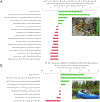The adaptive microbiome hypothesis and immune interactions in amphibian mucus
- PMID: 37001710
- PMCID: PMC10249470
- DOI: 10.1016/j.dci.2023.104690
The adaptive microbiome hypothesis and immune interactions in amphibian mucus
Abstract
The microbiome is known to provide benefits to hosts, including extension of immune function. Amphibians are a powerful immunological model for examining mucosal defenses because of an accessible epithelial mucosome throughout their developmental trajectory, their responsiveness to experimental treatments, and direct interactions with emerging infectious pathogens. We review amphibian skin mucus components and describe the adaptive microbiome as a novel process of disease resilience where competitive microbial interactions couple with host immune responses to select for functions beneficial to the host. We demonstrate microbiome diversity, specificity of function, and mechanisms for memory characteristic of an adaptive immune response. At a time when industrialization has been linked to losses in microbiota important for host health, applications of microbial therapies such as probiotics may contribute to immunotherapeutics and to conservation efforts for species currently threatened by emerging diseases.
Keywords: Antimicrobial peptides; Chytridiomycosis; Disease ecology; Homeostasis; Microbiota; Resilience; Stress physiology; Symbiosis.
Copyright © 2023 Elsevier Ltd. All rights reserved.
Figures







Similar articles
-
Interacting symbionts and immunity in the amphibian skin mucosome predict disease risk and probiotic effectiveness.PLoS One. 2014 Apr 30;9(4):e96375. doi: 10.1371/journal.pone.0096375. eCollection 2014. PLoS One. 2014. PMID: 24789229 Free PMC article.
-
Stability of microbiota facilitated by host immune regulation: informing probiotic strategies to manage amphibian disease.PLoS One. 2014 Jan 29;9(1):e87101. doi: 10.1371/journal.pone.0087101. eCollection 2014. PLoS One. 2014. PMID: 24489847 Free PMC article.
-
Inhibitory Bacterial Diversity and Mucosome Function Differentiate Susceptibility of Appalachian Salamanders to Chytrid Fungal Infection.Appl Environ Microbiol. 2022 Apr 26;88(8):e0181821. doi: 10.1128/aem.01818-21. Epub 2022 Mar 29. Appl Environ Microbiol. 2022. PMID: 35348389 Free PMC article.
-
Review of the Amphibian Immune Response to Chytridiomycosis, and Future Directions.Front Immunol. 2018 Nov 9;9:2536. doi: 10.3389/fimmu.2018.02536. eCollection 2018. Front Immunol. 2018. PMID: 30473694 Free PMC article. Review.
-
Mitigating amphibian chytridiomycosis with bioaugmentation: characteristics of effective probiotics and strategies for their selection and use.Ecol Lett. 2013 Jun;16(6):807-20. doi: 10.1111/ele.12099. Epub 2013 Mar 3. Ecol Lett. 2013. PMID: 23452227 Review.
Cited by
-
Amphibian mast cells serve as barriers to chytrid fungus infections.Elife. 2024 Jul 31;12:RP92168. doi: 10.7554/eLife.92168. Elife. 2024. PMID: 39082933 Free PMC article.
-
Immunohistochemical Characterization of Langerhans Cells in the Skin of Three Amphibian Species.Biology (Basel). 2024 Mar 23;13(4):210. doi: 10.3390/biology13040210. Biology (Basel). 2024. PMID: 38666822 Free PMC article.
-
The microbiome at the interface between environmental stress and animal health: an example from the most threatened vertebrate group.Proc Biol Sci. 2024 Sep;291(2031):20240917. doi: 10.1098/rspb.2024.0917. Epub 2024 Sep 18. Proc Biol Sci. 2024. PMID: 39291456
-
Linking microbiome and stress hormone responses in wild tropical treefrogs across continuous and fragmented forests.Commun Biol. 2023 Dec 12;6(1):1261. doi: 10.1038/s42003-023-05600-9. Commun Biol. 2023. PMID: 38087051 Free PMC article.
-
Bacteria from the skin of amphibians promote growth of Arabidopsis thaliana and Solanum lycopersicum by modifying hormone-related transcriptome response.Plant Mol Biol. 2024 Apr 14;114(3):39. doi: 10.1007/s11103-024-01444-x. Plant Mol Biol. 2024. PMID: 38615069 Free PMC article.
References
-
- Alibardi L, 2009. Embryonic keratinization in vertebrates in relation to land colonization. Acta Zoologica 90, 1–17. 10.1111/j.1463-6395.2008.00327.x - DOI
Publication types
MeSH terms
Grants and funding
LinkOut - more resources
Full Text Sources

